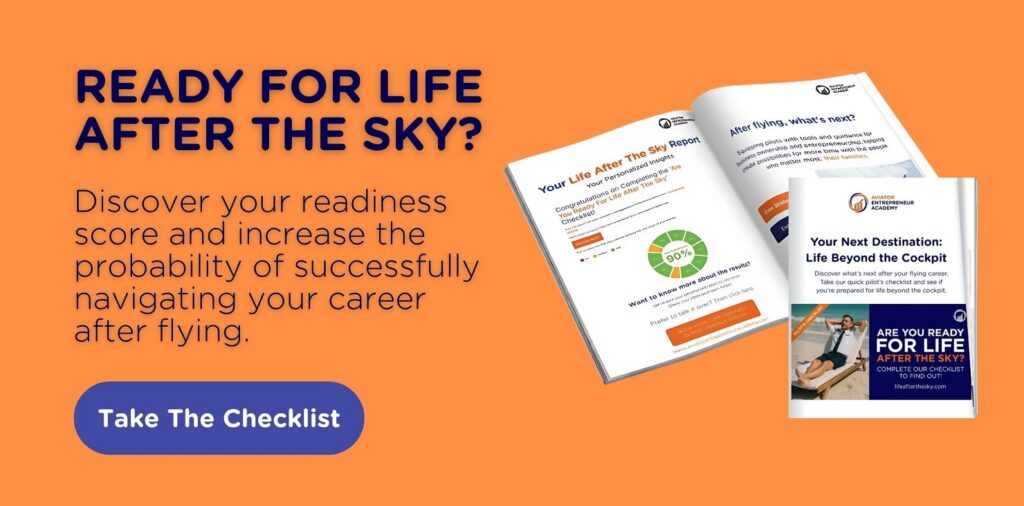When travelers book a ticket, they’re not buying an aircraft seat. They’re buying the chance to hug a loved one after years apart, to watch a sunset in a city they’ve only dreamed of, or to step into a business meeting that could change their future.
The airplane is just the bridge. What people are really paying for is the feeling of arrival, the story they’ll tell, and the memory they’ll carry forever.
That’s why the 90/10 rule matters: in aviation, the real value isn’t in the plane, but in the destination.
Key Takeaways
- Psychology of Buying: 85% of buying decisions come from future outcomes, not past credentials or processes. Focus on transformation, not details.
- The Pilot Trap: Talking too much about yourself, your background, or methods keeps customers disengaged. They want to know what will change for them.
- The 90/10 Rule: Spend 90% of your message on the customer’s destination (outcomes) and only 10% on your process or credibility.

The Psychology Behind the 90/10 Rule
Most people think customers make decisions based on credentials, features, or technical details. But human psychology works differently. Studies show 85% of buying behavior is based on anticipated future outcomes, while only 15% is influenced by past experiences.
That means people don’t buy what you’ve done or how you do it. They buy what they believe their future will look like after working with you.
When you spend too much time explaining your process, systems, or background, you’re focusing on the 15% that has the least impact. The 90/10 rule flips that around so you align your message with how people actually make decisions.
- 90% = Customer’s Destination: Paint the picture of their transformation. Show them the outcome, the improvement, and the future vision they’re craving. Help them see themselves at the finish line.
- 10% = Your Aircraft: Briefly explain how you’ll get them there. This is where your process, method, and credibility come in, but only after they’re emotionally invested in the destination.
The Pilot Trap: What Most Entrepreneurs Do Wrong
Most pilot-entrepreneurs unknowingly fall into what I call the pilot trap. You spend most of your sales pitch talking about yourself, such as your flight hours, training, systems, and processes.
It feels natural because aviation has conditioned you to prove competence before taking command.
In business, that same approach backfires.
Here’s how it usually looks: 70% of the conversation is spent on your background and credentials, 20% on your methodology, and only 10% on what the customer actually cares about, their outcomes.
What really converts is a clear vision of the customer’s experience, such as what their world will look and feel like after working with you.
The Transformed 90/10 Approach
The best way out of the trap is to flip the script with the 90/10 approach. Rather than leading with credentials and selling the value, you start with the transformation. In other words, 90% of your message should focus on where the customer is headed, such as the outcomes.
Only 10% of your time should be spent on figuring out how to make it happen. It should be enough to build credibility and reassure your customer that you can deliver.
Here’s what this sounds like in practice.
Instead of saying, “I apply aviation frameworks for decision-making and risk management,” you say, “After working with me, you’ll stop second-guessing yourself under pressure, and your team will work together smoothly in high-stakes moments.”
That’s destination talk. The customer immediately understands what changes in their world.
How Can Pilots Apply the 90/10 Rule?
It’s one thing to understand the 90/10 rule, but another to apply it in real conversations. That’s where the real impact lies. Many entrepreneurs fall back into “aircraft talk” because it feels safer to lead with their expertise.
Let’s discuss some common scenarios where you can apply this rule directly.
1. Business Consulting
Business owners don’t hire a consultant because they’re fascinated by frameworks. They hire one to solve costly problems.
If you spend most of your pitch explaining processes, they’ll tune out. Instead, focus on how their company will look and perform after working with you. Here’s an example to better understand this:
- Aircraft Talk (Wrong): “I use aviation-style crew resource management systems to improve communication and decision-making.”
- Destination Talk (Right): “Your team will make faster decisions under pressure, reduce costly mistakes, and resolve conflicts without losing time or trust.”
2. Leadership Training
Leaders want to be trusted, respected, and followed, not bogged down in theories and methodologies. If your training feels too technical, it misses the emotional and professional outcomes leaders actually want.
Therefore, ensure that you demonstrate how their role and presence will evolve after your program. An example for this would be:
- Aircraft Talk (Wrong): “My leadership program is built on 20 years of flying experience, aviation safety culture, and systematic risk assessment.”
- Destination Talk (Right): “You’ll make confident decisions in uncertainty, command trust in every room, and guide your team calmly through crises.”
In fact, Gallup’s research confirms that 70% of team engagement depends directly on the quality of leadership.
That’s why focusing on transformation connects more deeply than credentials.
3. International Business Consulting
When companies expand globally, fear of mistakes holds them back more than the actual regulations.
If you lead with technical details, they’ll feel overwhelmed. Instead, paint a picture of smooth expansion and growth, showing them what success looks like in practice. For instance:
- Aircraft Talk (Wrong): “I’ve flown to 50+ countries and understand international regulations and cultural nuances.”
- Destination Talk (Right): “You’ll expand into new markets without expensive compliance mistakes. You’ll build profitable partnerships across cultures and confidently navigate international growth while competitors struggle.”
Change the Way You Present, Change the Results
The 90/10 rule isn’t just another communication trick. It’s a mindset shift that changes how people see you and how quickly they trust you. When you lead with the “destination,” people lean in, connect, and take action.
If you’re making the same mistake, it’s time to make the shift.
With just 3 minutes, you can complete our Life After Sky checklist. It will show you exactly where you stand, what gaps to fix, and how to align your communication with what the audience is actually looking for.
Don’t keep flying the old route. Start focusing on destinations, not the aircraft.
Invitation to Join Our FREE Strategy Session
Most pilots are one honest conversation away from clarity. This is that conversation.
Complete our “Life After the Sky” checklist, then join me for a FREE 15-minute “Strategy Session” via Zoom.
This session has been created for pilots who want to take ownership of what comes next.
Those who want action, not just to talk about it.
In just 15 minutes, we’ll:
- Review your checklist results
- Identify the one obstacle holding back your reinvention
- Translate your checklist results into a clear starting point
Start your pre-flight assessment for the next chapter of your journey by Booking your free strategy session here!



